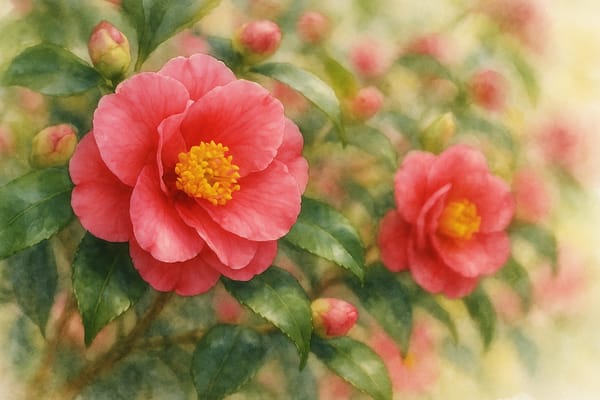From the sweeping estates of Caerhays and Heligan to tucked-away valley gardens hidden near Cornwall’s rugged coast, camellias have quietly become part of the county’s horticultural soul. Their glossy evergreen foliage and elegant blooms are not just a feast for the eyes; they tell a deeper story. One of adventure, adaptation, and a uniquely Cornish affinity for early spring colour.
The journey of camellias to Cornwall begins not in its sheltered coves, but far across oceans. These treasured plants arrived in Britain in the 18th century, brought by East India Company ships and carefully cultivated in the heated glasshouses of the wealthy. At first, they were precious — fragile symbols of exoticism and affluence, confined to conservatories where only the privileged could admire them.
But Cornwall, with its mild climate shaped by Atlantic winds, offered something few other parts of Britain could. Here, the camellia was given freedom to root itself in open ground. In Cornish gardens, soft with moisture and naturally acidic soil, camellias began to thrive outdoors long before the rest of the country dared such an experiment.
Some of the earliest champions of this outdoor cultivation were the great estates of Tregothnan and Caerhays Castle. Falmouth sea captains, returning from voyages east, added to Cornwall’s growing botanical treasures by introducing new camellia species into private gardens and estate collections. Then came J.C. Williams of Caerhays, a pioneering gardener who helped change camellia history by developing Camellia x williamsii — a hardy hybrid suited to life in the open Cornish landscape.
That legacy lives on today, not only in the springtime spectacle of Cornwall’s gardens but also in the National Camellia Collection at Mount Edgcumbe, where the story of this beloved plant is carefully preserved for future generations.
So why do camellias feel so at home in Cornwall? The region’s USDA hardiness zones (8 to 9), along with protection from severe winter frost, create a climate that suits them perfectly. Add in regular rainfall, acidic soils, and some shelter from harsh winds, and camellias reward their keepers with glorious early blooms in pink, white, and deep crimson — often appearing before winter has even loosened its grip.
That said, they do best when their needs are properly understood. Camellias prefer soil that is humus-rich, well-draining, and acidic, ideally between pH 5 and 6.5. They enjoy dappled shade or soft morning sun but dislike intense midday light. Wind can damage foliage, especially if it carries salt from the coast, so planting near walls, hedges, or sloping ground provides useful protection. A good mulch in spring using bark or leaf mould helps retain soil moisture, while rainwater is best for irrigation since it avoids the alkalinity that can build up from tap water. Light pruning after flowering helps keep them tidy, but heavy cutting should be avoided, especially after July when next year’s buds begin to form.
If your soil is alkaline or your garden is particularly exposed, camellias are very happy in containers. Choose a large, glazed or clay pot to insulate roots against temperature extremes, and fill it with ericaceous compost. Tuck the pot near a wall or hedge where it will be shielded from the wind. During winter storms, a gentle rinse with clean water can help remove salt spray from the leaves, and a wrap of horticultural fleece can protect flower buds during rare frosts.
Among the many camellia varieties that thrive in Cornwall, the Camellia x williamsii group stands out — not only for its resilience, but for its beauty and reliability. ‘St Ewe’ is often the first to flower, with bold, rich-pink blooms and vigorous growth. ‘Donation’ follows with soft pink petals and a long flowering season that makes it a favourite in many Cornish gardens. For something more unusual, ‘Jury’s Yellow’ produces creamy white blossoms with delicate yellow petaloids in the centre, adding a rare touch of softness to the spring palette.
These hybrids are also known for their clean habit — the flowers fall neatly without browning on the plant — and for their tolerance of both partial sun and shade. Their ability to thrive under variable conditions has made them enduring favourites among Cornish gardeners.
Across the UK, camellias have come a long way from their aristocratic beginnings in heated glasshouses. Today they are prized not just for their early colour and glossy evergreen leaves, but also for their low maintenance and structural presence throughout the year. Yet in Cornwall, their significance runs deeper still. Camellias speak of centuries of exploration, the passion of collectors and plant hunters, and a strong tradition of horticultural innovation. They are a reminder of Cornwall’s long connection to the sea and to distant lands, and of the region’s proud identity as a centre of botanical excellence.
More than ornamentals, camellias are part of Cornwall’s living history. Each one planted is not just a garden decision, but a link to a story that spans continents and centuries. With thoughtful care and the right setting, they flourish not only in great estates and famous gardens, but also in small plots and coastal cottages — blooming faithfully year after year as quiet heralds of spring.








